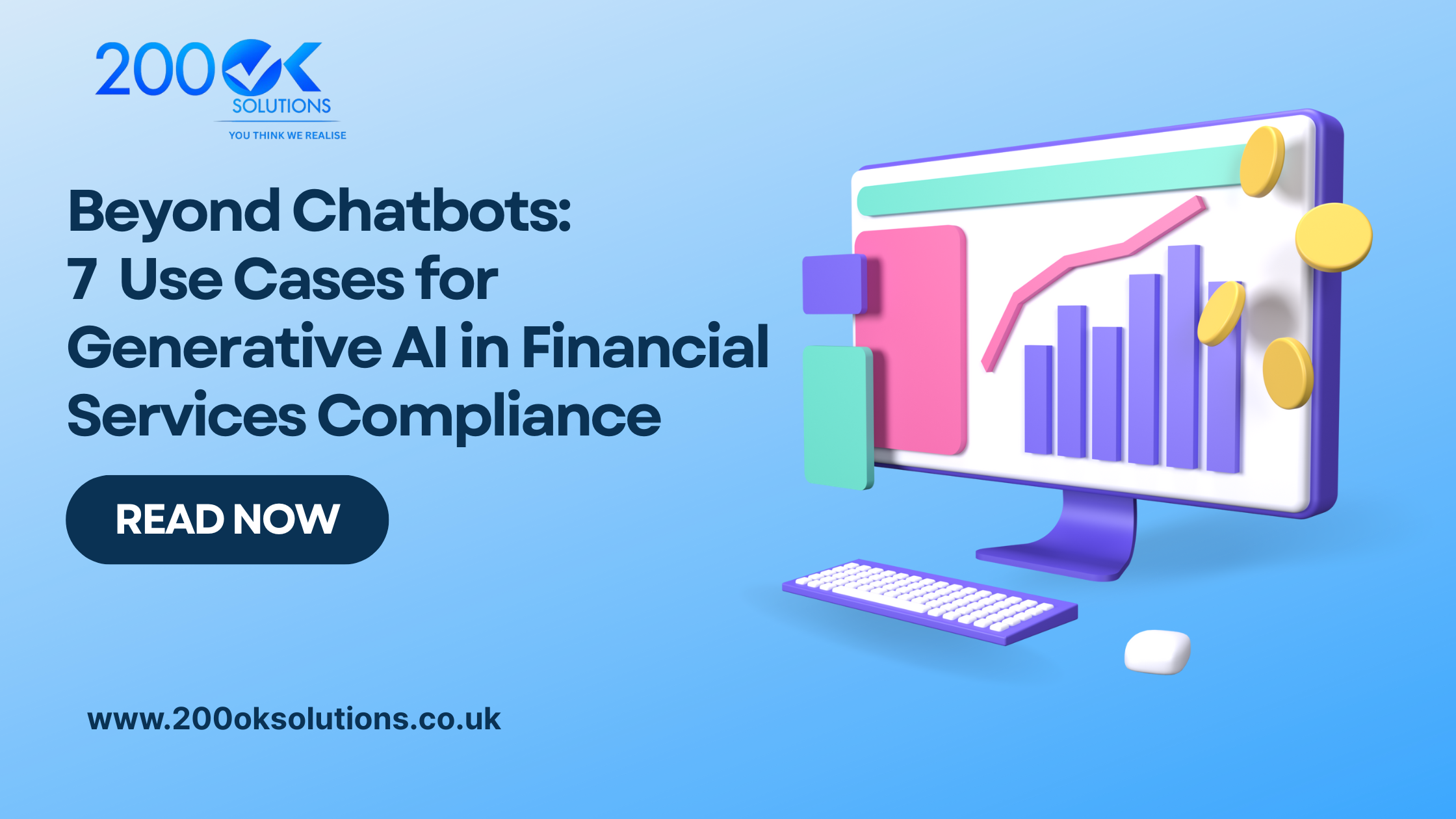While chatbots have dominated the conversation around generative AI finance applications, the technology’s most transformative impact in financial services lies in compliance operations. Generative AI is revolutionizing how financial institutions handle regulatory compliance, from automating anti-money laundering (AML) investigations to transforming regulatory reporting processes. This article explores seven critical use cases where GenAI risk management, fraud detection, and regulatory compliance AI are delivering measurable value beyond customer service applications, helping financial services organizations manage escalating compliance costs while improving accuracy and speed.
The financial services sector faces unprecedented compliance complexity. Banks, insurance companies, and fintech firms navigate an intricate web of regulations including financial authority requirements, anti-money laundering directives, data protection laws, and sector-specific rules. Traditional compliance approaches struggle to keep pace, with AI compliance spending consuming an ever-larger share of operational budgets while regulatory breaches continue to generate substantial fines.
Enter generative AI—technology that’s transforming how financial institutions approach their compliance obligations. While consumer-facing chatbots captured early attention, compliance professionals are discovering that generative AI use cases financial compliance organizations can implement deliver far more significant operational and risk management value.
Understanding Generative AI’s Role in Financial Services Compliance
Before exploring specific use cases, it’s essential to understand what distinguishes generative AI finance applications from traditional AI approaches in compliance contexts.
Traditional AI compliance tools typically focused on:
- Pattern recognition in transaction data
- Classification of documents or transactions
- Predictive scoring based on historical patterns
- Rule-based decision automation
Generative AI financial crime detection and compliance tools add fundamentally new capabilities:
- Natural language understanding: Comprehending complex regulatory texts, policies, and unstructured data sources
- Content generation: Creating compliance reports, summaries, and documentation
- Contextual reasoning: Understanding nuanced situations that don’t fit rigid rule sets
- Multi-source synthesis: Combining information from diverse sources to create comprehensive assessments
- Adaptive learning: Continuously improving performance based on feedback without explicit reprogramming
For UK financial services organizations, these capabilities address long-standing compliance pain points: the volume of unstructured data requiring review, the complexity of regulatory interpretation, the cost of manual processes, and the difficulty of maintaining consistency across large operations.
Use Case 1: Automated Anti-Money Laundering (AML) Investigation and Case Management
Anti-money laundering compliance represents one of the most resource-intensive obligations for UK financial institutions. Traditional AML systems generate vast numbers of alerts, with human investigators reviewing each case to determine whether it represents genuine suspicious activity.

The AML Challenge
Financial institutions face significant GenAI for AML compliance financial services UK challenges:
- Alert volumes: Automated transaction monitoring systems generate thousands of alerts daily
- False positive rates: 95% or more of alerts typically prove to be false positives after investigation
- Investigation time: Each alert requires 30-60 minutes of investigator time on average
- Documentation requirements: Every investigation must be thoroughly documented for regulatory review
- Skill requirements: Effective investigation requires experienced professionals who understand both financial crime patterns and regulatory requirements
How Generative AI Transforms AML Operations
GenAI financial crime detection capabilities revolutionize this process through several mechanisms:
Intelligent alert prioritization: GenAI analyzes alerts alongside contextual information (customer history, relationship patterns, external data) to prioritize cases most likely to represent genuine suspicious activity.
Automated preliminary investigation: The system conducts initial research, gathering relevant information from internal systems, open-source intelligence, and adverse media sources, presenting investigators with comprehensive case summaries rather than raw alerts.
Natural language case narrative generation: Generative AI finance tools automatically generate investigation narratives, documenting the investigator’s findings, reasoning, and conclusions in clear, compliant language.
Suspicious Activity Report (SAR) drafting: The system produces draft SARs based on investigation findings, incorporating required regulatory language and ensuring completeness.
Cross-case pattern identification: GenAI identifies connections between seemingly unrelated cases, uncovering sophisticated money laundering networks that single-case review might miss.

Implementation Considerations
Successful implementing GenAI for financial crime detection requires:
- Data integration: Connecting the GenAI system to transaction monitoring, customer databases, and external data sources
- Human oversight protocols: Establishing clear procedures for investigator review and approval of AI-generated content
- Audit trails: Maintaining comprehensive records of AI assistance in investigations for regulatory examination
- Performance monitoring: Tracking false positive rates, investigation times, and quality metrics
- Regulatory engagement: Communicating with the FCA about AI use in compliance processes
UK institutions implementing GenAI for AML compliance financial services UK capabilities report investigation time reductions of 40-60% while improving documentation quality and consistency.
Use Case 2: Know Your Customer (KYC) Due Diligence Enhancement
Customer due diligence represents another compliance area where generative AI finance applications deliver substantial value. UK financial institutions must verify customer identity, assess risk, and maintain current information throughout the customer relationship.

The KYC Compliance Burden
Traditional AI for KYC compliance in UK banking processes involve:
- Manual document collection and verification
- Internet searches for adverse media and politically exposed person (PEP) information
- Risk assessment based on customer characteristics and behavior
- Periodic reviews to ensure information currency
- Extensive documentation of due diligence procedures
These processes are time-consuming, inconsistent, and prone to human error, particularly for high-risk customers requiring enhanced due diligence.
Generative AI KYC Capabilities
AI in banking KYC processes enhanced by generative AI include:
Comprehensive information gathering: The system automatically searches diverse sources (corporate registries, news databases, sanctions lists, social media, court records) to build complete customer profiles.
Intelligent document analysis: GenAI extracts relevant information from identity documents, financial statements, corporate documents, and other sources, identifying inconsistencies or areas requiring additional verification.
Narrative risk assessment generation: Rather than simple risk scores, the system produces detailed narratives explaining customer risk factors, supporting evidence, and recommended risk mitigation measures.
Adverse media analysis: Generative AI fraud prevention finance UK systems analyze news articles and online content, distinguishing between material adverse information and irrelevant negative mentions sharing only a name.
Beneficial ownership analysis: For corporate customers, GenAI maps ownership structures, identifying ultimate beneficial owners even in complex multi-jurisdictional arrangements.
Ongoing monitoring synthesis: The system continuously monitors customers, generating alerts and updates when material information changes.
Practical Implementation
Financial institutions implementing AI for KYC compliance in UK banking should:
- Start with enhanced due diligence cases where manual effort is highest
- Establish clear quality standards for AI-generated content
- Implement multi-stage review processes combining AI and human judgment
- Create feedback mechanisms to improve system performance
- Document AI assistance in due diligence files for regulatory transparency
The generative AI use cases financial compliance UK organizations deploy for KYC typically reduce customer onboarding time by 50% while improving the depth and consistency of due diligence.
Use Case 3: Regulatory Change Management and Policy Update Automation
Financial services regulation evolves constantly. UK institutions must monitor regulatory developments, assess their impact, and update policies and procedures accordingly. This regulatory change management process consumes significant compliance resources.
The Regulatory Change Challenge
Regulatory compliance AI must address several difficulties:
- Volume of regulatory updates: The FCA, Prudential Regulation Authority (PRA), and other bodies publish hundreds of consultations, policy statements, and guidance documents annually
- Technical complexity: Regulatory texts are dense, technical, and often refer to other regulations
- Impact assessment difficulty: Determining which regulatory changes affect which business units and processes requires deep expertise
- Policy update coordination: Translating regulatory requirements into updated internal policies involves multiple stakeholders
- Evidence of compliance: Regulators expect institutions to demonstrate they’ve identified and responded to applicable regulatory changes

How Generative AI Streamlines Regulatory Change Management
GenAI policy summarization UK financial regs capabilities transform this process:
Automated regulatory monitoring: The system continuously monitors regulatory sources, identifying new and updated requirements relevant to the institution.
Intelligent summarization: Generative AI finance tools produce clear summaries of complex regulatory documents, highlighting key requirements, effective dates, and implementation obligations.
Gap analysis generation: GenAI compares new requirements against existing policies and procedures, identifying gaps requiring remediation.
Policy draft generation: The system produces draft policy updates incorporating new regulatory requirements in language consistent with the institution’s existing policy framework.
Stakeholder communication: GenAI generates tailored communications explaining regulatory changes to different audiences (board members, business units, front-line staff) at appropriate detail levels.
Implementation tracking: The system maintains comprehensive records of regulatory changes, institutional responses, and implementation evidence.
Implementation Best Practices
Effective AI compliance for regulatory change management requires:
- Regulatory taxonomy: Establishing clear categorization of regulations and their applicability to different business areas
- Review workflows: Implementing processes where compliance professionals review and validate AI-generated summaries and policy drafts
- Version control: Maintaining clear documentation of policy evolution in response to regulatory changes
- Training integration: Connecting regulatory change management to staff training systems to ensure awareness
- Regulatory relationship: Discussing AI-assisted regulatory change management with supervisors to ensure acceptance
Financial institutions implementing these capabilities report 60-70% reduction in time from regulatory publication to completed policy updates, while improving consistency and reducing the risk of overlooked requirements.
Use Case 4: Automated Regulatory Reporting and Data Quality Assurance
UK financial institutions submit numerous regulatory reports to the FCA, PRA, Bank of England, and other authorities. These reports demand significant data collection, validation, and formatting effort.
Regulatory Reporting Challenges
AI automated compliance reporting UK 2025 must overcome several obstacles:
- Data aggregation complexity: Reports require data from multiple systems with different formats and definitions
- Validation requirements: Regulators impose strict validation rules; errors result in resubmission requirements and potential enforcement action
- Narrative reporting: Many reports require explanatory narratives alongside quantitative data
- Submission deadlines: Late submissions trigger regulatory attention
- Audit trails: Institutions must document reporting processes and data lineage

Generative AI Reporting Capabilities
AI regulatory reporting enhanced by generative AI provides:
Intelligent data aggregation: The system understands reporting requirements and automatically collects relevant data from source systems, applying necessary transformations and reconciliations.
Validation rule application: GenAI applies regulatory validation rules, identifying errors and suggesting corrections based on understanding of business context.
Narrative generation: For reports requiring explanatory text, generative AI finance tools produce draft narratives explaining figures, significant changes, and unusual items.
Variance explanation: The system generates explanations for period-over-period changes or deviations from expected values.
Submission preparation: GenAI formats reports according to regulatory specifications and produces submission files.
Documentation generation: The system creates comprehensive documentation of data sources, transformation logic, and validation procedures for audit purposes.
Practical Deployment
Successful AI automated compliance reporting UK 2025 implementations:
- Begin with reports having clear, stable requirements
- Establish “four-eyes” review processes where human experts validate AI-generated content
- Implement parallel running periods where AI-generated reports are compared with traditional methods
- Create comprehensive audit trails documenting AI assistance
- Engage with regulators about AI use in reporting processes
Organizations deploying these capabilities typically reduce reporting preparation time by 40-50% while improving accuracy and consistency.
Use Case 5: Compliance Training Personalization and Knowledge Management
Effective compliance depends on staff understanding and following requirements. Traditional compliance training struggles with engagement, retention, and ensuring relevance to diverse roles.
Compliance Training Challenges
Financial institutions face significant training obstacles:
- Engagement difficulty: Generic compliance training fails to engage staff
- Relevance issues: Employees receive training on requirements not applicable to their roles
- Knowledge retention: Staff forget training content, particularly when infrequently applied
- Currency maintenance: Training materials require constant updating for regulatory changes
- Assessment limitations: Traditional testing poorly measures practical compliance understanding
- Just-in-time support: Staff need answers when questions arise, not weeks after training

How Generative AI Transforms Compliance Training
AI compliance training enhanced by generative AI includes:
Personalized learning paths: The system analyzes employee roles, responsibilities, and knowledge gaps to create tailored training programs focusing on most relevant requirements.
Interactive scenario-based learning: Generative AI finance tools create realistic compliance scenarios specific to the learner’s role, providing practice in applying requirements to practical situations.
Conversational learning assistant: Employees can ask compliance questions in natural language, receiving clear explanations with references to applicable policies and regulations.
Adaptive assessments: GenAI generates assessment questions that adapt based on responses, focusing on areas where the individual demonstrates uncertainty.
Microlearning generation: The system produces brief, focused learning modules on specific topics, supporting just-in-time learning when staff encounter unfamiliar situations.
Training content updates: When regulations or policies change, GenAI automatically updates training materials, ensuring currency without extensive manual revision.
Implementation Considerations
Deploying AI compliance training solutions requires:
- Integration with learning management systems: Connecting GenAI capabilities with existing training infrastructure
- Content governance: Establishing review processes for AI-generated training content
- Feedback loops: Collecting employee and supervisor feedback to improve training effectiveness
- Completion tracking: Maintaining records of training completion for regulatory requirements
- Effectiveness measurement: Assessing whether AI-enhanced training improves actual compliance behavior
Financial institutions implementing these approaches report improved training completion rates, higher assessment scores, and measurably better compliance behavior.
Use Case 6: Contract Analysis and Third-Party Risk Management
UK financial institutions engage thousands of third-party vendors, each relationship creating compliance obligations. Effective third-party risk management requires analyzing contracts, assessing vendor compliance capabilities, and monitoring ongoing performance.
Third-Party Risk Management Complexity
GenAI risk management for third parties must address:
- Contract volume: Large institutions maintain thousands of vendor contracts with varying terms
- Risk assessment requirements: Regulators expect comprehensive assessment of third-party risks, particularly for critical service providers
- Ongoing monitoring: Initial due diligence isn’t sufficient; institutions must continuously monitor vendor risk
- Contractual compliance: Ensuring vendors meet contractual obligations requires ongoing review
- Regulatory obligations: Specific regulations (like operational resilience requirements) impose extensive third-party management obligations

Generative AI Third-Party Risk Capabilities
Generative AI risk assessment finance compliance for vendors includes:
Contract analysis and extraction: GenAI reviews vendor contracts, extracting key terms (service levels, termination provisions, liability limitations, compliance obligations, data protection terms) and identifying potential risk issues.
Due diligence questionnaire analysis: Rather than manually reviewing lengthy vendor questionnaire responses, AI compliance tools analyze responses, identifying gaps, inconsistencies, or concerning answers.
Risk assessment narrative generation: The system produces comprehensive vendor risk assessments synthesizing information from contracts, due diligence, financial analysis, and external sources.
Ongoing monitoring: GenAI continuously monitors vendors for adverse media, financial deterioration, regulatory actions, or other risk indicators, generating alerts when material changes occur.
Contract obligation tracking: The system maintains inventory of contractual obligations and monitors compliance with reporting requirements, service levels, and other terms.
Vendor communication: Generative AI finance tools draft vendor communications regarding risk assessments, remediation requirements, and ongoing compliance obligations.
Deployment Best Practices
Implementing GenAI risk management for third parties requires:
- Contract repository: Centralizing vendor contracts in machine-readable formats
- Risk taxonomy: Establishing consistent risk categorization and assessment criteria
- Review workflows: Creating processes where risk managers review and validate AI-generated assessments
- Vendor engagement: Communicating with vendors about AI use in risk management
- Regulatory alignment: Ensuring AI-enhanced third-party risk management meets regulatory expectations
Organizations deploying these capabilities reduce third-party risk assessment time by 50-60% while improving consistency and comprehensiveness.
Use Case 7: ESG Compliance Reporting and Impact Analysis
Environmental, Social, and Governance (ESG) requirements have become central to UK financial services regulation. Institutions must measure, report, and manage ESG risks across their operations and portfolios.
ESG Compliance Challenges
Generative AI ESG reporting finance UK addresses several difficulties:
- Data collection complexity: ESG metrics require data from diverse internal and external sources
- Reporting framework diversity: Multiple ESG reporting frameworks with different requirements
- Narrative reporting: ESG reports require extensive qualitative disclosure alongside quantitative metrics
- Portfolio analysis: Financial institutions must assess ESG characteristics of investment portfolios and lending books
- Regulatory evolution: ESG requirements continue evolving, creating ongoing compliance uncertainty
- Stakeholder communication: Different audiences (regulators, investors, customers, public) require tailored ESG communications
How Generative AI Enhances ESG Compliance
Financial services AI for ESG compliance includes:
ESG data aggregation and gap analysis: GenAI collects ESG-relevant data from internal systems and external sources, identifying data gaps that prevent comprehensive reporting.
Framework mapping: The system maps the institution’s data and practices to various ESG reporting frameworks (TCFD, GRI, SASB), identifying compliance with each framework.
Narrative report generation: Generative AI ESG reporting finance UK tools produce draft ESG reports combining quantitative data with clear narrative explanations of strategy, governance, and impact.
Portfolio ESG analysis: For investment and lending portfolios, GenAI analyzes ESG characteristics, identifying concentrations, risks, and opportunities.
Scenario analysis: The system helps model ESG scenarios (like climate change impacts) on portfolios and operations, producing analysis required for regulatory stress testing.
Stakeholder communication: GenAI tailors ESG information for different audiences, producing regulatory submissions, investor reports, and public disclosures from common underlying data.
Implementation Considerations
Deploying generative AI ESG reporting finance UK capabilities requires:
- ESG data strategy: Establishing processes for collecting and validating ESG data
- Framework selection: Determining which ESG frameworks the institution will follow
- Review processes: Implementing governance for reviewing and approving AI-generated ESG content
- Audit readiness: Maintaining documentation supporting ESG disclosures for regulatory and investor scrutiny
- Continuous improvement: Regularly enhancing ESG data quality and reporting sophistication
Financial institutions implementing these capabilities report 40-50% reduction in ESG reporting preparation time while improving disclosure quality and stakeholder satisfaction.

Addressing Implementation Challenges: Overcoming GenAI Adoption Barriers in Financial Compliance
While the use cases demonstrate substantial value, challenges GenAI adoption financial compliance are significant. UK financial institutions must thoughtfully address several critical issues.
Regulatory Uncertainty and Model Risk Management
Regulatory compliance AI deployment faces uncertainty about regulatory acceptability:
Regulatory guidance limitations: UK financial regulators have provided limited specific guidance on generative AI use in compliance functions.
Model risk management: Traditional model risk management frameworks don’t directly apply to generative AI’s probabilistic, non-deterministic nature.
Explainability requirements: Regulators expect institutions to explain compliance decisions; GenAI’s “black box” characteristics create explanation challenges.
Mitigation approaches:
- Engage proactively with regulators about GenAI use cases and governance
- Implement human-in-the-loop processes where compliance professionals review AI outputs
- Develop comprehensive documentation of GenAI system capabilities, limitations, and validation
- Start with use cases where AI assists rather than replaces human judgment
- Create audit trails demonstrating human oversight and approval
Data Privacy and Confidentiality
Generative AI finance systems require access to sensitive customer and business data:
Privacy risks: Training or prompting GenAI with personal data creates data protection compliance risks.
Confidentiality concerns: Potential for inadvertent disclosure of confidential information through AI system outputs.
Third-party AI services: Using cloud-based GenAI services raises questions about data sharing with technology providers.
Mitigation approaches:
- Implement data anonymization and pseudonymization before GenAI processing
- Use on-premises or private cloud deployments for highly sensitive compliance applications
- Establish clear data governance for what information can be processed by GenAI systems
- Conduct Data Protection Impact Assessments for GenAI compliance applications
- Ensure contractual protections when using third-party GenAI services
Accuracy and Hallucination Risks
Generative AI systems can produce plausible-sounding but incorrect content—so-called “hallucinations”:
Compliance implications: Incorrect compliance advice, flawed risk assessments, or inaccurate regulatory reporting could trigger enforcement action.
Reputation risk: AI-generated compliance failures could damage institutional reputation.
Mitigation approaches:
- Implement validation processes where human experts review AI outputs
- Use retrieval-augmented generation (RAG) architectures that ground AI responses in verified source documents
- Establish confidence thresholds where low-confidence outputs require additional review
- Create feedback mechanisms to identify and correct errors
- Maintain comprehensive testing programs for GenAI compliance applications
Skills and Change Management
Successful AI in banking compliance requires organizational adaptation:
Skill requirements: Compliance professionals need new skills combining compliance expertise with AI understanding.
Role evolution: AI assistance changes compliance roles; organizations must manage this transition thoughtfully.
Cultural resistance: Some compliance staff may resist AI adoption, fearing job displacement.
Mitigation approaches:
- Invest in training programs helping compliance staff work effectively with AI tools
- Position AI as augmenting rather than replacing compliance professionals
- Involve compliance teams in AI solution design and implementation
- Celebrate successes and share benefits broadly
- Provide clear career pathways for compliance professionals in AI-enhanced environment
The Strategic Imperative: Why UK Financial Institutions Must Embrace GenAI Compliance Applications
The trends GenAI in UK fintech compliance 2025 make clear that generative AI adoption in compliance is no longer optional. Several factors create strategic imperative:
Cost Pressure
Compliance costs continue escalating while revenues face pressure. Generative AI finance applications offer one of the few opportunities for substantial compliance cost reduction without compromising quality.
Regulatory Complexity
Regulatory requirements grow in volume and complexity. Human-only compliance approaches increasingly cannot keep pace. AI compliance capabilities become necessary to manage the burden.
Competitive Dynamics
Early adopters of financial services AI for compliance gain cost advantages and risk management capabilities. Institutions that delay adoption risk competitive disadvantage.
Talent Availability
Competition for experienced compliance professionals intensifies. AI in banking compliance helps institutions accomplish more with existing staff while making compliance roles more attractive through reduced manual work.
Regulatory Expectations
While current regulatory guidance is limited, trajectory is clear: regulators expect institutions to leverage technology, including AI, for effective compliance. Institutions demonstrating thoughtful AI adoption position themselves favorably.
Innovation Foundation
Compliance GenAI capabilities create infrastructure and expertise that enable broader AI adoption across the institution, generating benefits beyond compliance.

Practical Steps: How to Begin Your GenAI Compliance Journey
For UK financial institutions ready to move beyond chatbots GenAI in finance compliance, here’s a practical roadmap:
Step 1: Assessment and Prioritization (Months 1-2)
Conduct compliance process inventory: Document current compliance processes, identifying pain points, resource consumption, and quality issues.
Assess GenAI readiness: Evaluate data availability, technical infrastructure, skills, and organizational culture.
Prioritize use cases: Select initial use cases based on potential value, implementation difficulty, and risk. The 7 use cases GenAI regulatory compliance banking framework provides structure for this assessment.
Establish governance: Create oversight structure for GenAI compliance initiatives, including risk management, compliance, technology, and business representation.
Step 2: Pilot Implementation (Months 3-6)
Select pilot use case: Choose one or two high-value, lower-risk use cases for initial implementation.
Establish success metrics: Define clear measures of pilot success (time reduction, quality improvement, cost savings, user satisfaction).
Implement with strong governance: Deploy pilot with comprehensive oversight, documentation, and validation processes.
Collect feedback: Gather detailed feedback from compliance staff using GenAI tools.
Document learnings: Create comprehensive documentation of what worked, what didn’t, and why.
Step 3: Validation and Refinement (Months 6-9)
Measure results: Assess pilot performance against success metrics.
Validate accuracy: Conduct thorough accuracy assessment of AI-generated outputs.
Refine processes: Adjust workflows, prompts, and oversight procedures based on pilot learnings.
Develop scaling plan: Create roadmap for expanding successful use cases and implementing additional applications.
Engage regulators: Proactively communicate with supervisors about GenAI use and seek feedback.
Step 4: Scaling and Expansion (Months 9-18)
Expand successful use cases: Roll out proven applications more broadly across the organization.
Implement additional use cases: Deploy GenAI for additional compliance functions based on prioritization.
Build internal capabilities: Develop internal expertise in GenAI for compliance through training and hiring.
Establish centers of excellence: Create specialized teams supporting GenAI compliance applications across the organization.
Continuous improvement: Implement ongoing processes for monitoring performance, gathering feedback, and enhancing capabilities.
Step 5: Strategic Integration (Months 18+)
Enterprise integration: Connect GenAI compliance capabilities with broader enterprise AI initiatives.
Advanced applications: Explore more sophisticated use cases combining multiple GenAI capabilities.
Industry engagement: Participate in industry forums sharing learnings and influencing regulatory approaches.
Innovation program: Establish ongoing programs for identifying and testing emerging GenAI capabilities.
The Compliance Function of the Future
The integration of generative AI use cases financial compliance UK organizations are implementing today fundamentally reshapes the compliance function. The compliance professional of the future combines deep regulatory knowledge with AI collaboration skills, focusing on judgment, oversight, and strategic risk management rather than routine document review and manual processes.
This evolution creates opportunities to attract different talent profiles to compliance—individuals excited by technology and innovation rather than deterred by manual work. It enables compliance to shift from cost center to strategic function providing competitive advantage through superior risk management and regulatory relationships.
For UK financial institutions, the question isn’t whether to adopt regulatory compliance AI and generative AI finance applications for compliance, but how quickly and effectively to do so. The 7 use cases GenAI regulatory compliance banking explored here—from AML investigation to ESG reporting—represent proven applications delivering substantial value today.
Organizations that move decisively, thoughtfully addressing implementation challenges while learning from early deployments, position themselves for success in an increasingly complex regulatory environment. Those that delay face mounting costs, growing risks, and competitive disadvantage.
The journey beyond chatbots GenAI in finance compliance into sophisticated compliance applications represents one of the most impactful technology transformations UK financial services will experience in the coming years. The institutions that embrace this transformation, combining human expertise with AI capabilities, will define the future of financial services compliance.
Frequently Asked Questions
Q: Is generative AI in financial compliance approved by UK regulators?
A: UK regulators haven’t issued prohibitions on GenAI use in compliance. The FCA and PRA expect institutions using AI to demonstrate appropriate governance, risk management, and oversight. Proactive engagement with supervisors about your specific use cases is advisable.
Q: How can we ensure generative AI doesn’t make compliance mistakes?
A: Implement human-in-the-loop processes where compliance professionals review AI outputs, use RAG architectures grounding AI in verified sources, establish validation processes, and maintain comprehensive audit trails. AI should augment, not replace, human judgment in compliance.
Q: What skills do compliance staff need to work with generative AI?
A: Compliance professionals need to understand GenAI capabilities and limitations, know how to effectively prompt and interact with AI systems, be able to critically evaluate AI outputs, and combine AI assistance with their compliance expertise. Training programs addressing these areas are essential.
Q: How long does it take to implement generative AI for compliance?
A: Initial pilot implementations typically take 3-6 months. Meaningful scaling across multiple use cases generally requires 12-18 months. Timeline depends on organizational readiness, data quality, and complexity of selected use cases.
Q: What’s the ROI of generative AI in compliance?
A: Organizations typically report 40-60% reduction in time for compliance processes where GenAI is deployed, alongside quality and consistency improvements. ROI varies by use case but generally delivers payback within 12-24 months.
About 200OK Solutions
At 200OK Solutions, we help UK financial services organizations navigate the complex journey of implementing generative AI for compliance. Our team combines deep financial services compliance expertise with advanced AI capabilities to deliver solutions that meet both regulatory expectations and business objectives. Whether you’re exploring initial use cases or ready to scale GenAI across your compliance function, we’re here to help you succeed. Contact us to discuss how generative AI can transform your compliance operations.


